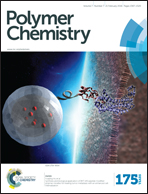Vinylidenedithiophenmethyleneoxindole: a centrosymmetric building block for donor–acceptor copolymers†
Abstract
Further development of new building blocks is crucial for realizing next-generation, high-performance organic semiconducting materials. In the paper, the design and synthesis of a novel π-extended analogue of isoindigo, vinylidenedithiophenmethyleneoxindole (VDTOI), and two VDTOI-based copolymers is reported. The centrosymmetric VDTOI unit possesses a special acceptor–donor–acceptor structure and contains a highly planar conjugated backbone because of the presence of S⋯O conformational locks. Of special importance is the fact that the VDTOI unit has the highest occupied molecular orbital (HOMO) and lowest unoccupied molecular orbital and energy levels of −5.35 eV/−3.42 eV, which are similar properties to those of the thiophene-flanked diketopyrrolopyrrole building block. The previously mentioned structural features indicate that VDTOI might be a potential building block for constructing polymeric semiconductors. As a trial, two VDTOI-based copolymers were synthesized, namely P1 and P2. The two copolymers show good thermal stability and broad absorption spectra ranging from 330 to 740 nm. Their HOMO energy levels of around −5.40 eV match well with the work function (5.13 eV) of a gold (Au) electrode, which is indicative of effective hole injections from the Au electrodes to polymer semiconductor films. Both the P1- and P2-based field-effect transistors exhibited typical p-type transport characteristics. The highest mobility of 0.35 cm2 V−1 s−1 was achieved in P1-based devices.


 Please wait while we load your content...
Please wait while we load your content...